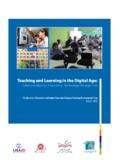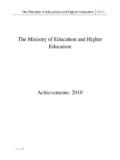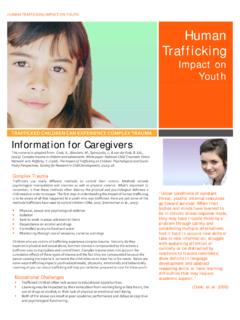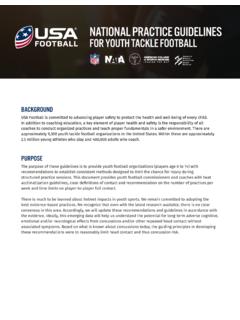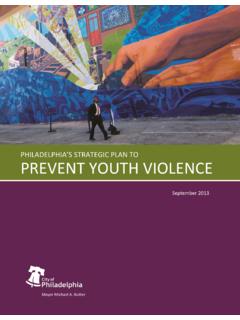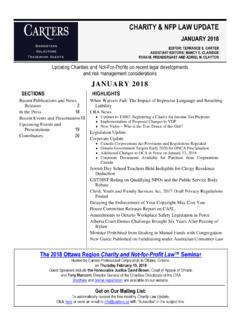Transcription of Ministry of Education and Higher Education, Lebanon
1 Ministry of Education and Higher Education , Lebanon Reaching All Children with Education : RACE II (2017-2021) August 2016 1 TABLE OF CONTENTS ACRONYMS EXECUTIVE SUMMARY CHAPTER I: impact OF THE SYRIA CRISIS ON Lebanon Overview of the refugee crisis in Lebanon The context for children and youth in Lebanon Education for refugee and affected communities Issues: Access to Education Opportunities Issues: Quality of Education Services Issues: Lebanese National Education System CHAPTER II: THE RACE II PROGRAMME PILLAR I: Improved access to Education opportunities PILLAR II: Improved quality of Education services PILLAR III: Strengthened capacity of the Education system CHAPTER III: MONITORING AND EVALUATION List of RACE II impact , Outcome, Outputs statements and indicators Calculation of impact and Outcome indicators Assumptions, risks, and mitigation measures CHAPTER IV: PARTNERSHIPS AND COORDINATION ANNEXES 1.
2 RACE II logframe 2. Education systems in Lebanon 3. Organisational structures of the Ministry of Education and Higher Education 2 ACRONYMS ALP Accelerated Learning Programme BLN Basic Literacy and Numeracy BTS back-to-school CERD Centre for Educational Research and Development CFS Child Friendly Spaces DOPS Department of Orientation and Guidance ECE Early Childhood Education ESDP Education Sector Development Plan ESP Effective School Profile GoL Government of Lebanon IT information technology KAP knowledge, attitudes and practices Learning spaces Any physical space outside MEHE premises used to deliver regulated NFE programmes MEHE Ministry of Education and Higher Education MICS Multiple Indicator Cluster Survey NFE non-formal Education .
3 This document refers only to MEHE-regulated NFE programmes NGO non-governmental organization NLG No Lost Generation PMU Programme Management Unit PSS psychosocial support REC RACE Executive Committee SIP school improvement plan SOPs standard operating procedures TIMSS Trends in International Mathematics and Science Study TVET Technical and Vocational Education and Training UNDP United Nations Development Programme UNESCO United Nations Educational, Scientific and Cultural Organization UNHCR United Nations High Commissioner for Refugees UNICEF United Nations Children s Fund USAID United States International Development Agency VASyR Vulnerability Assessment of Syrian Refugees 3 EXECUTIVE SUMMARY The RACE II Strategy (2017-2021) is being developed at a key transitional moment for Lebanon .
4 The Syrian Crisis shows little sign of abating and the impact of this inter-generational Crisis continues to echo around the region. The MEHE and Education Partners acknowledge that existing systemic resource and capacity gaps will continue to widen; thereby impacting access to, and the quality of, social and protective services for vulnerable children, youth , and their families. Substantial investments into the Lebanese Education sector via RACE I has had noteworthy outcomes for children, both vulnerable Lebanese and non-Lebanese alike. Two significant successes stand out; first, that enrolment rates of Lebanese children into public school returned to pre-Crisis levels. Secondly, over 42% of (compulsory school-age) refugee children received a certified Education despite significant documentation barriers.
5 RACE II seeks to build on RACE I, envisaging now a more strategic approach to the Education sector response, on the premise of a stabilization and development agenda through these key strategic shifts: Aligning with the SDGs Goal 4 on Education , RACE II will seek to integrate human right, child rights, and child protection principles, as key to its interventions Ensuring that quality Education opportunities are available for the most vulnerable children and families; whether they be non-Lebanese or Lebanese. MEHE and its partners will implement systemic and holistic interventions that address both the demand for, and the availability of, quality public Education services. An acceleration towards ensuring that all children and youth aged 03-18 years are enrolled in quality and inclusive Education opportunities.
6 This explicitly expands the Sector s responsibility to support Education opportunities for all throughout their life-cycle; from early childhood Education , to improving quality of teaching services for primary, secondary, and vocational Education , and a focus on equipping children and youth with effective life-skills. With an overarching vision for children and youth therefore, RACE II aims to contribute to furthering the equitable right to a quality and relevant Education for all children and youth between 03-18 years of age in Lebanon , by addressing policy, systems, quality service-delivery and demand bottlenecks at the national, subnational and community levels. Based on mutual trust and respect, a financing and delivery compact will greatly increase the delivery of quality Education services for children, and a transparent accounting of monies invested towards their future.
7 While MEHE commits to; a. A significant increase in the number of students enrolled into formal Education b. Improving the curriculum, teaching quality, learning environments, and learning materials c. Increasing transition rates and decreasing dropout rates in formal Education d. Regulating NFE opportunities as a pathway to formal Education e. Improving efficiency and accountability of its institutions f. A transparent accounting of monies and progress of RACE II through periodic reviews Donors are requested to; 1. Commit to large-scale, multi-year financing to exclusively support the RACE II framework 2. Support current RACE II costing estimates for at least $350m a year ($ over five years) 3. Support MEHE and its institutions develop their capacity to lead the planning, implementation, budgeting, coordination, and monitoring of RACE II 4 CHAPTER I: impact OF THE SYRIA CRISIS ON Lebanon OVERVIEW OF THE REFUGEE CRISIS IN LEBNON Now in its sixth year, the Syrian Crisis has had a significant impact on Lebanon , its peoples, and its institutions.
8 The Government of Lebanon currently hosts an estimated over million Syrian refugees, in addition to an estimated 500,000 Palestinian refugees and 50,000 Lebanese returnees from Syria. Lebanon now fronts the list of countries with the highest refugee-per-capita, globally1. The World Bank assessed that the impact of the Syria Crisis on Lebanon may have cut GDP growth by points per year, could double the unemployment rate (especially for youth ), depress government revenue collection by US$ billion while increasing government expenditure by US$ billion; totalling a fiscal impact of US$ billion to reinstate the Lebanese public services to their pre-2011 levels2. This has magnified the spread of poverty and pressure on the fabric of communities.
9 To illustrate in comparison with 2011 data, there were 61% more Lebanese classified as poor in 2015. Demographic estimates from 56 cadastres indicate that the population has more than doubled, while in 84 other cadastres the population has increased by 50 to 100%.3 While this has resulted in contention over limited resources between host and refugee communities, there has not yet been open inter-community violence. Concerns are beginning to rise however, over Lebanon s fragile political and social balance. The Government of Lebanon and its institutions, civil society, and the international community are therefore united on the need to develop durable strategies to enable Lebanon to respond to the crisis through national institutions, systems, and organizations.
10 Figure 1: Distribution and evolution of displaced Syrians in Lebanon4 1 2 Lebanon : Economic and Social impact Assessment of the Syrian Conflict. World Bank, September 2013 3 Lebanon Crisis Response Plan 2015-16 4 Adapted from historical UNHCR registration data and MEHE enrolment data, May 2016 5 THE CONTEXT FOR CHILDREN AND youth IN Lebanon Children and youth in Lebanon bear a substantial burden of the impact from the Crisis. Around million children and youth in Lebanon are currently identified as being vulnerable5. July 2016 estimates from UNHCR indicated that Lebanon hosts 488,236 children and youth (aged between 03-18 years). Of this population, approximately 42% of the compulsory school-age cohort ( , 06-15 years of age) were enrolled in formal public Education programmes, during the 2015/16 scholastic year.
